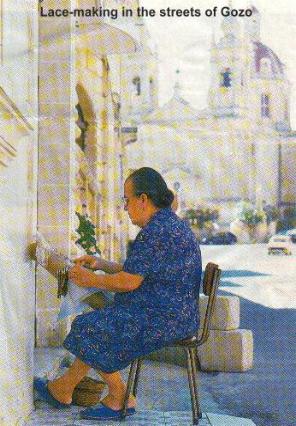|
BIZZILLA a craft handed over by the Knights
 In 1839 Thomas McGill, who issued A Handbook, or Guide, for Strangers visiting Malta, wrote that "the females of the Island make also excellent lace; the lace mitts and gloves wrought by the Malta girls are bought by all ladies coming to the island; orders from England are often sent for them on account of their beauty and cheapness. "
In 1839 Thomas McGill, who issued A Handbook, or Guide, for Strangers visiting Malta, wrote that "the females of the Island make also excellent lace; the lace mitts and gloves wrought by the Malta girls are bought by all ladies coming to the island; orders from England are often sent for them on account of their beauty and cheapness. "
The 18th century, by which time lace was already a well-established local industry, provides iconographic evidence of its use in various paintings by Francesco Zahra (1710-1773) and Antoine de Favray (1706-1798), representing high dignitaries of the Order of St John ecclesiastics and Maltese ladies of society.
Agius De Soldanis also records in his dictionary that Malta lace had achieved a high degree of perfection and compared favourably with that produced by Dutch women. Its widespread use for adomment may be inferred from the fact that lace was included with other articles in a bando or proclamation enacted by Grand Master Ramon Perellos in 1697 aimed at repressing the wearing of gold, silver, jewelry, cloth of gold, silks and other materials of value.
The Maltese word for lace bizzilla, suggests a comparatively recent origin. In fact its introduction to these islands can date further back than the 16th century, when the art of lace-making, probably introduced into Venice from the East began to spread in Europe.
From Venice the new technique was soon taken up by Genoa, where pillow lace, as distinct from Venetian point lace, developed. Modem Maltese lace is descended directly from Genoese lace.
To quote from Mincoff and Marriage (Pillow Lace, 1907), "This heavier Genoese lace was made from 1625 onwards. Its lineal descendant is modern Maltese, which was introduced into the island by laceworkers broght from Genoa in 1833 by Lady Hamilton-Chichester.. "Though Genoses by extraction the industry, flourishing exceedingly in Malta, has developed a character of its own, retaining as essential the Genoese leafwork but very little of its solid tapes, light twists taking their place. Characteristic is also the Maltese cross in the patterns and the cream or black silk in which the lace is usually worked."

From the above one may infer that lacemaking, a flourishing industry in the 18th century, fell on evil days and was on the decline during the first years of British rule, and therefore, rather than introduce it into Malta, Lady Hamilton-Chichester helped to revive the industry in 1833. It is a fact that this date coincides roughly with a period of considerable revival and expansion. About the same time lacemaking spread to the whole of Gozo and became a thriving industry there through the efforts of two priests: Canon Salvatore Bondi (1790-1859) and Fr Joseph Diacono (1847-1924).
Lace figured among the objects sent from Malta to the Exhibition of Industries held in London in 1881. The commercial potential of bobbin lace as developed in Malta led British ntissionaries to copy and introduce local patterns in the Far East, both in China and India. Patterns were copied first in silk and later in linen and cotton thread.
There is a steady demand for lace by tourists. To ensure the survival of this ancient craft, lacemaking is taught in Government trade schools for girls, while private bodies such as the Society of Arts, Manufactures and Commerce also hold special evening classes. From time to time exhibitions are held. Besides arousing public awareness of the cultural importance of this aspect of Maltas national heritage, such initiatives also inspire deeper study of the history and techniques of local lace among womens organisations and in academic circles.
| 
